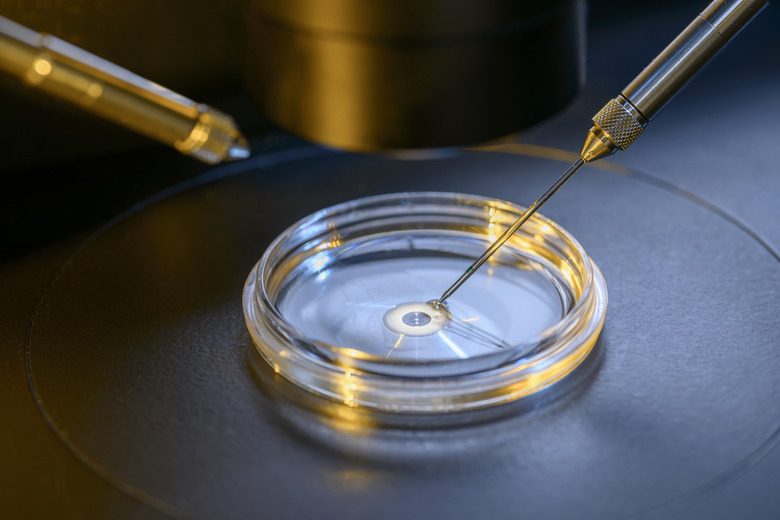What Happens To A Zygote Following Fertilization?
A fertilized egg is called a zygote until it divides into 16 cells, forming a ball-shaped structure called a morula. The events during the zygote stage involve the integration of both parents' DNA into the cell nucleus and the beginning of rapid cell division, or cleavage. In humans, it takes about four days for a zygote to become a morula and another three days until the embryo attaches itself to the mother's uterine wall.
Immediate Reaction
Immediate Reaction
Once a sperm has safely docked inside an egg cell, the egg takes steps to keep other sperm out. This is the cortical reaction, in which the egg releases thousands of membrane-bound cortical granules into the pellucid zone — the zona pellucida — surrounding the egg's plasma membrane. The granules contain enzymes that trigger a second, or zona, reaction that blocks the entry of other sperm by hardening the zone structure and destroying the egg's sperm receptors. The egg cell, which had been suspended in the middle of meiosis, now resumes this process.
Completion of Meiosis
Completion of Meiosis
Meiosis is the process that creates gametes — sperm and egg cells — containing only one, or a haploid, set of chromosomes. Fertilization establishes the regular diploid number of chromosomes in the zygote. Meiosis occurs over two cycles of cell division, which sperm cells complete before fertilization. Meiosis in the egg cell stops during metaphase of the second cycle. At fertilization, meiosis II resumes and the duplicate copies of each chromosome are pulled apart. The egg retains a set, while the other is dispatched to a polar body that separates from the egg and eventually degrades.
Pronuclei Stage
Pronuclei Stage
The tightly packed chromosomes in the sperm now begin to decondense and are surrounded by a temporary membrane that forms the paternal pronucleus. Enzymes from the egg cell assist in the formation of the paternal pronucleus. The egg cell develops its own pronucleus as well. During the next 12 to 18 hours, the DNA in each pronucleus replicates, forming chromosomes with twin attached chromatids. The two pronuclei attach to an array of microtubules anchored by a structure called an aster. The microtubules pull the two pronuclei together.
Mitosis
Mitosis
Once the pronuclei are drawn together, their membranes dissolve. The fertilized egg now prepares for mitosis, which is the distribution of duplicated chromosomes to two daughter cells. During mitosis, the chromosomes align on a central spindle where the duplicates separate and are pulled to either end of the cell. The cell divides, with each daughter cell roughly half the size of the original egg. The cells undergo three more cycles of mitosis, which is called cleavage because the cells don't enlarge during this stage. By the fourth day, the 16 cells form the morula, which eventually develops into a baby.
Cite This Article
MLA
Finance, Eric Bank, MBA, MS. "What Happens To A Zygote Following Fertilization?" sciencing.com, https://www.sciencing.com/happens-zygote-following-fertilization-20062/. 11 July 2019.
APA
Finance, Eric Bank, MBA, MS. (2019, July 11). What Happens To A Zygote Following Fertilization?. sciencing.com. Retrieved from https://www.sciencing.com/happens-zygote-following-fertilization-20062/
Chicago
Finance, Eric Bank, MBA, MS. What Happens To A Zygote Following Fertilization? last modified March 24, 2022. https://www.sciencing.com/happens-zygote-following-fertilization-20062/
